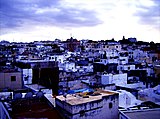
The Plaza de Toros de Las Ventas, known simply as Las Ventas, is the largest bullfighting ring in Spain, located in the Guindalera quarter of the Salamanca district of Madrid. It was inaugurated on June 17, 1931. Its seating capacity of 23,798, makes it the third-largest bullfighting run in the world, after bullrings in Mexico and Venezuela, respectively. After the federal ban of bulfighting in Plaza México, Las Ventas is the second largest bullring in the world still in operation for its original intention.

A bullring is an arena where bullfighting is performed. Bullrings are often associated with the Iberian Peninsula, but they can also be found through Iberian America and in a few Spanish and Portuguese ex-colonies in Africa. Bullrings are often historic and culturally significant centres that bear many structural similarities to the Roman amphitheatre.

The Plaza de Torosde Acho is the premier bullring in Lima, Peru. Located beside the historical center of the Rímac District, the plaza is classified as a national historic monument. It is the oldest bullring in the Americas and the second-oldest in the world after La Maestranza in Spain. It opened on 30 January 1766.

Palacio de Deportes de la Comunidad de Madrid, officially WiZink Center since November 2016 for sponsorship reasons, is an indoor sporting arena located in Madrid, Spain.

El Fandi is statistically one of the most skilled matadors in the world. Currently, he is ranked number one among all bullfighters in Spain.

Álvaro de Figueroa y Torres-Sotomayor, 1st Count of Romanones was a Spanish politician and businessman. He served as Prime Minister three times between 1912 and 1918, president of the Senate, president of the Congress of Deputies, Mayor of Madrid and many times as cabinet minister. He belonged to the Liberal Party. Romanones, who built an extensive political network, exerted a tight control on the political life of the province of Guadalajara during much of the Restoration period. He also was a prolific writer, authoring a number of history essays.
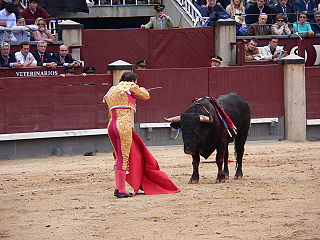
Bullfighting is a physical contest that involves a bullfighter attempting to subdue, immobilize, or kill a bull, usually according to a set of rules, guidelines, or cultural expectations.
Bullfighting was banned in the Spanish autonomous community of Catalonia by a vote of the Catalan Parliament in July 2010. The ban came into effect on 1 January 2012. The last bullfight in the region took place on 25 September 2011 at La Monumental. The ban was officially annulled for being unconstitutional by Spain's highest court on 5 October 2016. However, despite the overturning of the ban, no further bullfight had taken place in Catalonia as of July 2020.

The Plaza de Toros Monumental de Barcelona, often known simply as La Monumental, is a bullring in the city of Barcelona, Catalonia, Spain. It was the last bullfighting arena in commercial operation in Catalonia. It was inaugurated in 1914 under the name Plaza de El Sport and was soon expanded and given its current name in 1916. It is situated at the confluence of the Gran Via and Carrer Marina in the Eixample district. It has a capacity of 19,582 within 26 rows of lines, boxes, and stands on the first floor inside and an upper gallery surrounding the building.
Paco Cano Lorenza, also known as Canito, was a Spanish photojournalist from Valencia, who specialized in torero photography.

La Tauromaquia (Bullfighting) is a series of 33 prints created by the Spanish painter and printmaker Francisco Goya, which was published in 1816. The works of the series depict bullfighting scenes. There are also seven extra prints that were not published in the original edition.
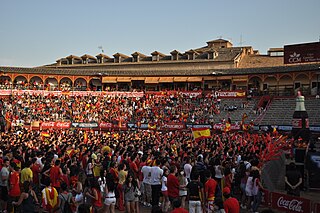
The bullring is a building located in Toledo, Castile-La Mancha, Spain.

Marcos de Celis Salvador was a Spanish bullfighter.

Santa Cruz Bullring is a bullring in Santa Cruz de Tenerife, Spain. Opened in 1893, it hosted its last bullfight in 1983. After being used for a variety of other events it closed in 2003, and is now vacant, with potential plans to redevelop it. It was listed as a Bien de Interés Cultural in 2014.
Juan José García Corral, was a Spanish bullfighter and director of the Escuela Tauromaquia of Salamanca
Pablo Lozano Martín, commonly known as La Muleta de Castilla, was a Spanish bullfighter and fighting bull cattle rancher, owner of cattle raising Alcurrucén and "Hermanos Lozano".

The Plaza de Toros de Pontevedra (Spain) is the bullring of the Spanish city of Pontevedra and the only one in the autonomous community of Galicia. It has a capacity of 7,800 spectators and is classified as the second category of Spanish bullring. The current bullring replaced a wooden one dating from 1892, although the tradition of bullfighting in Pontevedra dates back to the 17th century.
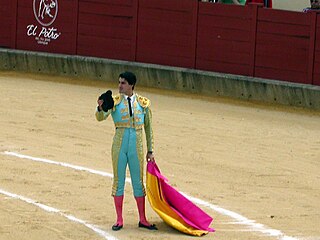
Jesús Janeiro Bazán, better known as Jesulín de Ubrique, is a Spanish torero or bullfighter.
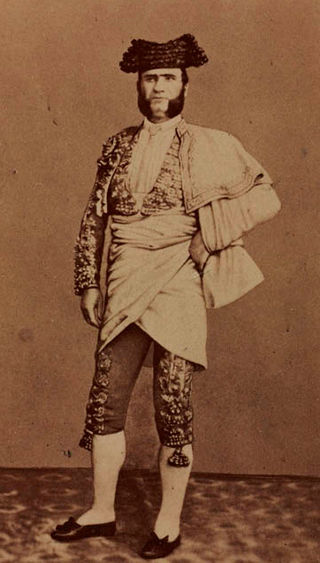
José Dámaso Rodríguez y Rodríguez, known as Pepete, was a Spanish bullfighter in the mid-19th century. He was the first notable matador known by this nickname.
The Plaza de toros El Progreso was a bullring in the Mexican city of Guadalajara, Jalisco. It was used for bullfighting and also for hosting musical events. The venue could hold 14,000 people and was built in 1856.

















